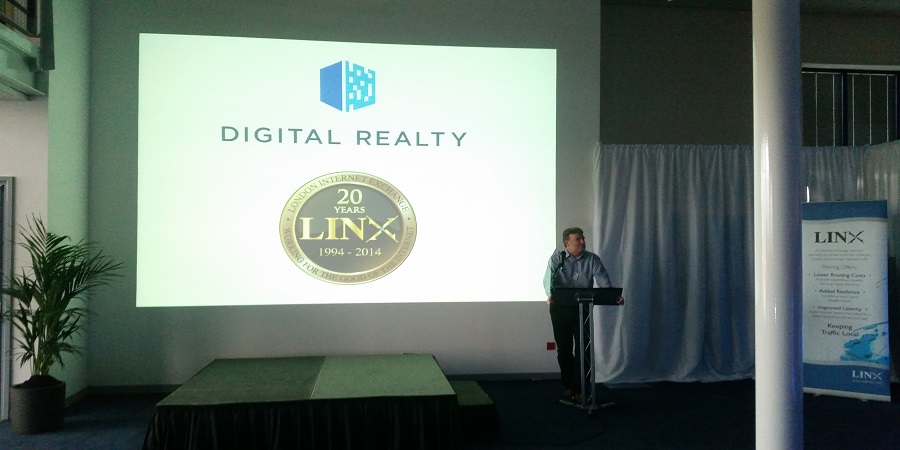A couple of news items caught my eye today – firstly Digital Realty Trust announcing GMEX Technologies, who run a Recognised Investment Exchange, as a new customer into their Chessington site, the same site that is also the home of the newest LINX (London Internet Exchange) node with John Souter, LINX CEO, pictured on the day of the grand opening in 2014.
In my mind this is a further piece of evidence that shows how serious the company is about attacking the retail colocation market and building an ecosystem out in Chessington, another small step forward therefore it would seem.
Then another email in my Inbox this morning from Virtus, now offering a DDOS mitigation service – so quite a journey for Virtus from a focussed wholesale provider (though admittedly one aiming at the mid-tier part of the wholesale market) to a full service colocation provider. Its been a busy 2015 for Virtus who announced the second 3MW phase of their new Hayes facility was being fitted out in June and then a significant new shareholder in ST Telemedia shortly thereafter. I guess we should be watching for news about further growth with the new investor on board in due course.
In general then, yet more evidence to suggest the shift of focus from wholesale data centre providers towards the retail colocation market is continuing, a point we’ve been commenting on for some time. The impact this trend has had is one of the key aspects featured in our 2015 report on the London colocation market, full details of which can be found via this link.
We can account for some 1.3m sq ft of built out net technical capacity from wholesale operators in and around London at present, so clearly wholesale can have quite an impact on the supply/demand analysis included in our report as well as on the recent pricing trends over the past few years, where pricing has been most under pressure and those (few) pockets where pricing power remains very much with the operator. This difference in pricing trends has created some significant premiums in one part of the market and narrowed discounts in others. As a result its been a really interesting year to write our report.
Market Capacity Numbers – a HOT TOPIC!
Included in our 2015 report is a full breakdown of capacity available from now no less than the 60 carrier neutral colocation facilities available in and around London and of course there is much interest in this topic as the Equinix bid for Telecity trundles on. Equinix will understandably be keen to show the combined company (Equicity) will not have too great a market share, so no doubt having a strong argument to say wholesale capacity should now be included as direct retail competition will help their case by broadening to the widest extent possible the size of the colocation market overall (see our previous article on Equicity market share numbers on how much this affects the numbers).
On the other hand, whilst former wholesale operators do indeed represent a new and usually competitively priced option for retail colocation buyers, it is still very early days for them in this part of the market (eg only one LINX port in use so far in DRT Chessington) and as a result, despite the huge amount of wholesale capacity available (both now or potentially) in the London colocation market, I would suggest their actual market share of retail for now is still pretty low. Clearly market share numbers in London and elsewhere across the European colocation market will come under close scrutiny over the next few months as the Equinix bid seeks regulatory approval, but in the meantime the trend of wholesale into retail shows no signs of abating.
